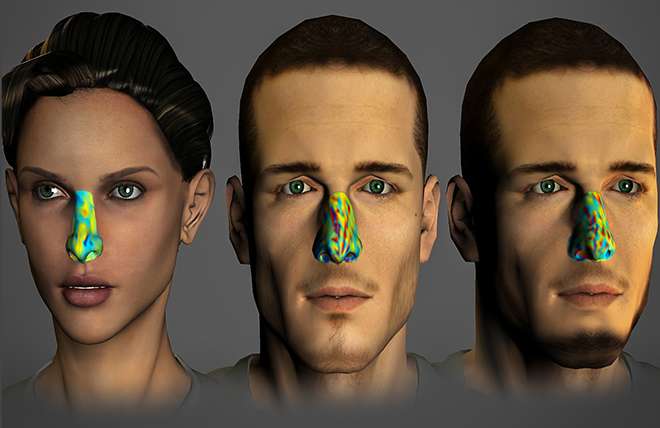June 23, 2015 report
Sniff tests used to create olfactory fingerprint

(Medical Xpress)—A team of researchers with affiliations to several institutions in Israel has developed a way to test the differences in the way people perceive odors. The differences are enough, the team reports in their paper published in Proceedings of the National Academy of Sciences that it is possible to uniquely indentify individuals based solely on their sense of smell.
Though most people perceive odors in similar ways, scientists have known for some time that there are some small variations, but until now, there has not been a way to test those differences. To come up with such a test, the researchers started with knowledge gained from prior research that had found that approximately 30 percent of the human genome responsible for encoding olfactory receptors differs from person to person. To learn more about the perception differences that come about because of that, the researchers developed a system of test questions that took into account 28 different odors along with 54 descriptive words that a person taking the test could use to describe one of the odors. The team then recruited 89 volunteers to take sniff tests and then to use the designated words to describe what they smelled.
In analyzing the data, the researchers noted that average descriptions of the odors was quite similar among the volunteers, but that there was enough variance among them to create what they call an olfactory fingerprint—a unique perceptual experience—so unique that it could be used to identify each of the volunteers when given another set of tests. More experimentation showed that the tests could be refined to the point where it would take just 10 odors and 11 descriptive words to accurately build an olfactory fingerprint for one individual, or taking it further, using 34 odors and 35 descriptive words to create olfactory fingerprints for everyone alive today.
In another series of experiments, the team enlisted the assistance of 130 volunteers—this time they compared human leukocyte antigens (blood proteins involved in immunity response) for each person, with their olfactory fingerprints and found that those people that matched well with antigens, matched closely in their olfactory fingerprints as well, suggesting a means for testing for immunity compatibility.

The team believes their testing system could be used to help diagnose diseases that impact the sense of smell and perhaps, because of the unique signature, in security applications.
More information: Individual olfactory perception reveals meaningful nonolfactory genetic information Lavi Secundo, PNAS, DOI: 10.1073/pnas.1424826112
Abstract
Each person expresses a potentially unique subset of ∼400 different olfactory receptor subtypes. Given that the receptors we express partially determine the odors we smell, it follows that each person may have a unique nose; to capture this, we devised a sensitive test of olfactory perception we termed the "olfactory fingerprint." Olfactory fingerprints relied on matrices of perceived odorant similarity derived from descriptors applied to the odorants. We initially fingerprinted 89 individuals using 28 odors and 54 descriptors. We found that each person had a unique olfactory fingerprint (P < 10−10), which was odor specific but descriptor independent. We could identify individuals from this pool using randomly selected sets of 7 odors and 11 descriptors alone. Extrapolating from this data, we determined that using 34 odors and 35 descriptors we could individually identify each of the 7 billion people on earth. Olfactory perception, however, fluctuates over time, calling into question our proposed perceptual readout of presumably stable genetic makeup. To test whether fingerprints remain informative despite this temporal fluctuation, building on the linkage between olfactory receptors and HLA, we hypothesized that olfactory perception may relate to HLA. We obtained olfactory fingerprints and HLA typing for 130 individuals, and found that olfactory fingerprint matching using only four odorants was significantly related to HLA matching (P < 10−4), such that olfactory fingerprints can save 32% of HLA tests in a population screen (P < 10−6). In conclusion, a precise measure of olfactory perception reveals meaningful nonolfactory genetic information.
© 2015 Medical Xpress


















